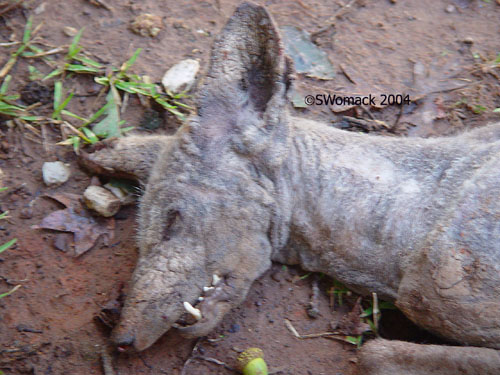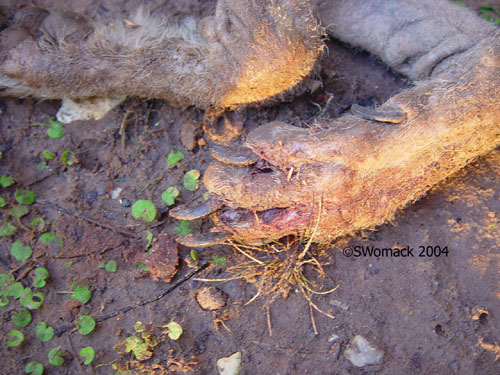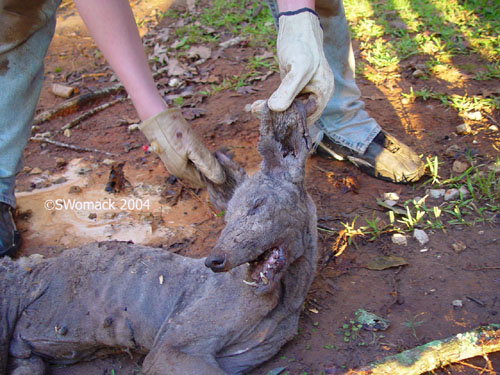
This first image shows that it is indeed very similar in appearance to the Elmendorf Chupacabra. It's fairly doggish, hairless and blue-gray, with characteristics that remind folks of kangaroos or, alternately, muntjac deer.

This second shows how strange its head is. The fangs are disproportionately large, and the lower jaw is far shorter one would expect for that long of a snout. The skin looks very scabby and distorted, giving the face a rat-like appearance. Let's just say it: This thing looks creepy.

The third photo lays to rest speculation about the animal being a deer. Cervids have hooves, and those are definitely doggish toes and claws. It's not a kangaroo mutant, either, as the foot structure is all wrong for those marsupials. Yes, the claws are somewhat long for a dog, but I've seen Labradors with toenails that long, so it's not unheard of.

This image gives a sense of scale. I still can't see this as a coyote with mange. The skull shape is wrong, and the animal itself is too small. Coyotes are significantly larger creatures. However, someone has suggested this may be a diseased fox, and that is certainly more plausible. The ears and skull shape are more akin to a fox than a coyote, and the size fits.
Stacy Womak, with 20 years of zoo and veterinarian experience, said the creature was killed underneath her mother's house. Their larger dogs were barking at the thing, but refused to go under the house after it. For good reason, apparently. This wasn't just any chupacabra--it's a zombie chupacabra:
"It was so necrotic, its tissue was just rotted," Womack said. "It had no hair, a severe overbite and its claws were entirely too long for a dog."
She said the animal's front legs were much smaller than it's hind legs, and that despite it's overall ghoulish appearance, it's extremely long canine teeth were in excellent condition. Also, despite having been shot, there was virtually no blood seeping from the animal's carcass. The animal's ear also "broke like a cookie" when it's head was held up for a photograph, she said
"It's body looked like something that has been dead for a month or so," Womack said. "Like I said, I've worked in the veterinary field for more than 20 years and I've never seen anything that bad."
The animal was male and weighed between 15 and 20 pounds, she said. The identical animal that sprinted across the road ran with it's head down and it's tail between it's legs, according to Womack, but wasn't tall enough to be a coyote or a wolf. She said the live animal is probably the dead one's mate.
Can you imagine baby zombie chupacabras running around? And we already know these things are in Elmendorf--folks there say they've seen them around before and after that one was killed in July. Of course, the folks in Elmendorf are a bit curious about this new creature. Who wants to bet they challenge Pollok residents for the right to call their city "Chupacabra Capital of the World."
Now Playing: Paul McCartney Off The Ground

I know what it is, and yes you were right about it being more closely related to a fox. They are actually a subspecies of the type I'm... *ahem* more familiar with... I'm planning to put up species profiles for them on my website, but until then... The ones most commonly seen are called Solocuths, the other more typical species are called Meccalyn. I have lived with meccalyn my whole live and they never hurt anyone so I suspect that the Solocuth form will only kill livestock, as it has so far (ranging from baby chickens to cows). If anyone NEEDS to know more email me at ebbalynn13@yahoo.com
ReplyDeleteIt looks like a large hairless Chinese Crested to me
ReplyDeleteIt's clearly just a diseased dog/fox like animal. Probably mange.
ReplyDeleteIf it is very sick, underweight or dehydrated (or considerably or decomposed, if it is a long-dead animal, which I suspect many vso called "chupacabras are") - this will cause the skin/tissue to shrink away from the teeth/claws, making them appear disproportionately large. The same effect causes the appearance of nail/hair growth in human corpses, when in fact hair and nails do not grow after death (how could they possibly?).
Disease and/or decay could easily alter the natural skin colour, and with fur - who really knows the exact shade of a coyote's skin anyway? Certainly looking under my pet cat's fur, there are parts of his skin which appear quite grey in colour. A lot of dogs also have a greyish skin colour.
Additionally, the lack of fur will make the animal seem smaller than it would normally appear, and will distort it's apparent shape away from what we are used to.
With fur, we are unable to identify how "kangaroo-like" dogs/foxes/cats legs are, but if you get your pet cat/dog at home, and actually feel the length of its hind leg / stretch it out (kindly and gently ofc) - you will find that it is suprisingly long, and kangaroo-leg shaped. The thigh/knee is simply usually tucked up into the flank of the animal, and hidden by fur.
All of this explanation aside... every so-called "chupacabra" corpse which has so far been genetically tested has turned out to be a coyote or fox with mange and/or parasites... so there's the proof really.